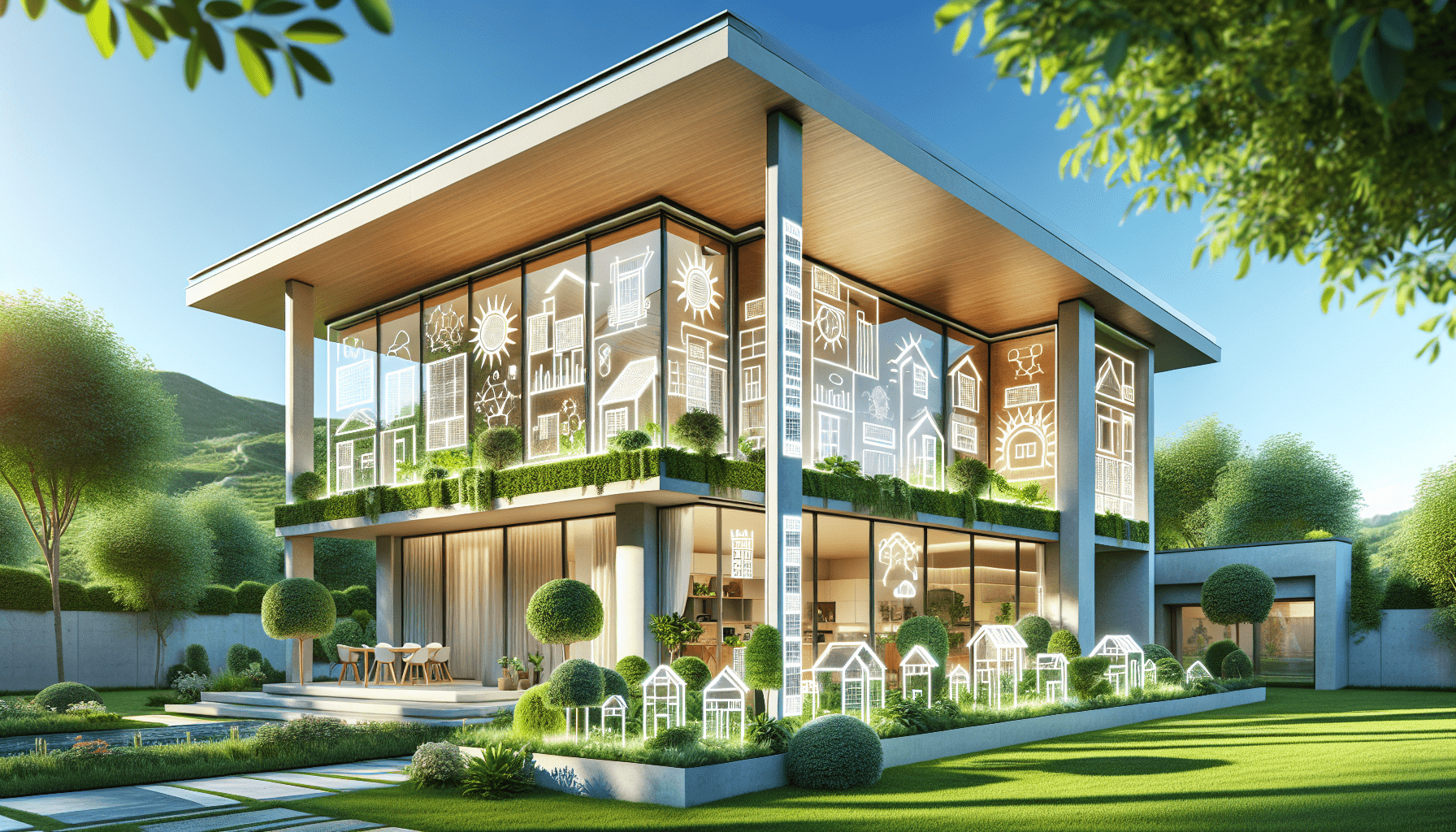Welcome to our exploration of passive solar design in sustainable architecture! In this article, we’ll journey through the fundamentals of passive solar design, a pivotal aspect of environmentally conscious construction. We’ll uncover how this innovative approach harnesses natural sunlight to minimize the need for artificial heating, cooling, and lighting, ultimately paving the way for energy-efficient buildings that are kind to our planet. Join us as we delve into the principles, benefits, and real-world applications of passive solar design, and discover how it plays a crucial role in shaping the future of sustainable living. Have you ever wondered what passive solar design is in sustainable architecture? It’s a fascinating topic that blends the ingenuity of human engineering with the natural energy provided by the sun. By leveraging passive solar design, we can create buildings that not only reduce our reliance on non-renewable energy sources but also provide superior comfort and aesthetic qualities. Join us as we delve into the intricacies of this sustainable architectural practice, exploring its principles, benefits, and applications.

What Is Passive Solar Design?
Passive solar design is an approach in architecture that maximizes the use of solar energy in building design without relying on mechanical or electrical systems. This technique utilizes building elements—such as walls, windows, and floors—to collect, store, and distribute solar energy in the form of heat in the winter and reject solar heat in the summer, thus providing natural heating, cooling, and lighting.
Core Principles of Passive Solar Design
Understanding the core principles behind passive solar design is essential to grasping its transformative potential. These principles include orientation, insulation, thermal mass, window placement, and shading.
Orientation
Orientation refers to the positioning of the building relative to the sun. By strategically placing a building, we can maximize the amount of sunlight that enters the structure during the heating seasons while minimizing it during the cooling seasons.
- North Hemisphere: Buildings should be oriented with the long axis running east-west. The majority of windows should face south to avoid the extreme heat of the midday sun.
- South Hemisphere: Conversely, in the southern hemisphere, the primary windows should face north to accomplish the same benefits.
Insulation
Proper insulation acts as a barrier to heat flow, significantly impacting a building’s energy efficiency. Insulating the building envelope—comprising walls, roofs, and floors—helps to maintain a consistent internal temperature by reducing heat loss in winter and heat gain in summer.
Thermal Mass
Thermal mass pertains to the materials within a structure that can absorb, store, and release heat. Materials such as concrete, brick, and stone are excellent at maintaining thermal mass. They absorb heat during the day and release it as temperatures drop, helping to regulate indoor temperatures naturally.
Window Placement
Window placement and design are crucial for optimizing the benefits of passive solar design. Windows let in sunlight, providing natural light and heat. However, excessive glazing without proper planning can result in over-heating or significant energy loss.
Shading
Strategic shading helps control the amount of heat and light entering a building. This can be achieved through fixed or adjustable elements, such as awnings, overhangs, and vegetation.
Benefits of Passive Solar Design
Passive solar design offers numerous advantages that benefit both the environment and building occupants. These include energy efficiency, reduced carbon footprint, lower operating costs, and improved comfort.
Energy Efficiency
By harnessing the sun’s energy, passive solar design significantly reduces the need for conventional heating and cooling systems. This translates to lower energy consumption and reduced utility bills.
Reduced Carbon Footprint
As passive solar buildings rely less on fossil fuels, they produce fewer greenhouse gas emissions. This helps mitigate climate change and contributes to a cleaner, healthier planet.
Lower Operating Costs
Although passive solar design might involve higher upfront costs, it results in substantial savings over a building’s lifespan. Reduced energy consumption translates to lower maintenance and operating expenses.
Improved Comfort
Passive solar buildings offer superior thermal comfort, providing stable indoor temperatures year-round. Occupants experience enhanced well-being with an abundance of natural light and reduced exposure to temperature fluctuations and drafts.
Key Elements of Passive Solar Design
Implementing passive solar design involves various elements and techniques. Some key components include direct gain systems, indirect gain systems, and isolated gain systems.
Direct Gain Systems
Direct gain systems are the simplest and most common approach in passive solar design. They involve allowing sunlight to directly enter and heat the interior spaces of a building.
South-Facing Windows
In direct gain systems, south-facing windows are used to capture and distribute solar energy. The following table illustrates the benefits and considerations for south-facing windows:
| Benefit | Consideration |
|---|---|
| Efficient heating during winter | Risk of overheating in summer |
| Reduced need for artificial lighting | Heat loss during nighttime |
| Cost-effective and simple to implement | Glare and fading of furnishings |
Thermal Mass
As mentioned earlier, materials with high thermal mass, such as concrete and stone, play a crucial role in direct gain systems. These materials absorb and store solar energy, helping maintain a consistent indoor temperature.
Indirect Gain Systems
Indirect gain systems employ an intermediary storage element between the sun and the living spaces, typically using materials with high thermal mass. This approach offers better control over heat distribution.
Trombe Wall
The Trombe wall is a classic example of an indirect gain system. It consists of a dark, heat-absorbing wall situated behind glass on the building’s sun-facing side. The wall collects and stores solar heat, which is then slowly transferred indoors.
| Component | Function |
|---|---|
| Glass | Allows sunlight to pass through and heat the wall |
| Trombe Wall | Absorbs and stores heat during the day |
| Vents | Facilitate natural heat transfer to indoor spaces |
Water Wall
A water wall operates similarly to a Trombe wall but uses water instead of solid materials. Water walls are effective due to water’s high heat capacity, making them highly efficient at storing and releasing thermal energy.
Isolated Gain Systems
Isolated gain systems separate solar collection from the main living spaces, typically through sunspaces or solar greenhouses. These systems offer additional flexibility and control over heat distribution.
Sunspace
A sunspace, or solar room, acts as a buffer zone that collects solar energy. This space can either be opened to the main living areas for heating or closed off if overheating is a concern.
| Feature | Benefit |
|---|---|
| Versatility | Can function as a living area or thermal buffer |
| Additional Space | Provides extra living or recreational space |
| Controlled Heating | Allows for regulated heat distribution |
Design Strategies for Different Climates
Designing passive solar buildings requires careful consideration of the climate. Each climate zone demands specific strategies to optimize energy efficiency and comfort.
Hot and Arid Climates
In hot and arid climates, passive solar design prioritizes cooling and shading to maintain comfortable indoor temperatures.
Key Strategies:
- Orient buildings to minimize solar gain.
- Use materials with high reflectivity to prevent heat absorption.
- Incorporate shaded outdoor living areas to reduce cooling loads.
- Maximize natural ventilation to enhance cooling.
Cold and Temperate Climates
In cold and temperate climates, the goal is to maximize solar gain during the winter while minimizing heat loss.
Key Strategies:
- Orient buildings to capture maximum winter sunlight.
- Use materials with high thermal mass to store heat.
- Install large, south-facing windows to allow sunlight to penetrate the interior.
- Utilize insulated walls, roofs, and floors to prevent heat escape.
Hot and Humid Climates
In hot and humid climates, passive solar design aims to reduce humidity and enhance ventilation to maintain indoor comfort.
Key Strategies:
- Design buildings with wide overhangs and shaded areas.
- Use materials that promote natural ventilation.
- Incorporate reflective roofing materials to decrease solar heat gain.
- Plan openings and windows to facilitate cross-ventilation.
Case Studies of Passive Solar Design
Examining real-life examples of passive solar design can provide valuable insights into its effectiveness and versatility.
Case Study 1: The Chesapeake Bay Foundation’s Brock Environmental Center
Located in Virginia Beach, this building is an excellent example of passive solar design combined with other sustainable practices.
- Orientation: The building is oriented to optimize daylight and solar heat gain.
- Insulation: It features high-performance insulation in the walls and roof.
- Thermal Mass: The concrete floors act as thermal mass, regulating indoor temperature naturally.
- Shading: Overhangs and sunshades control solar heat gain, reducing the need for air conditioning.
Case Study 2: The Waldsee BioHaus
Located in Minnesota, the BioHaus demonstrates passive solar design in a cold climate.
- Orientation: South-facing orientation maximizes solar gain in winter.
- Insulation: High levels of insulation are included in the building envelope.
- Thermal Mass: Walls and floors incorporate materials with high thermal mass.
- Windows: Large, triple-pane south-facing windows enhance heat retention.

Challenges and Solutions in Passive Solar Design
While passive solar design offers numerous benefits, it also presents some challenges that must be addressed.
Overheating
One of the primary challenges of passive solar design is the risk of overheating, especially in warmer climates.
Solutions:
- Shading Devices: Use overhangs, awnings, and vegetation to block excessive sunlight.
- Ventilation: Incorporate natural ventilation to expel excess heat.
- Thermal Mass: Increase thermal mass to absorb and store excess heat for gradual release.
Initial Costs
Passive solar design can involve higher upfront costs due to the need for specialized materials and design considerations.
Solutions:
- Long-Term Savings: Focus on the significant energy savings and reduced operational costs over the building’s lifespan.
- Incentives: Seek out government incentives, rebates, and grants for sustainable building practices.
Aesthetic Considerations
Balancing functional design with aesthetic appeal can be challenging, particularly for owners with specific stylistic preferences.
Solutions:
- Design Integration: Work with architects and designers experienced in blending passive solar principles with diverse architectural styles.
- Customization: Tailor passive solar elements to align with the desired aesthetic while maintaining functionality.
Future of Passive Solar Design
As environmental awareness and the demand for sustainable practices grow, passive solar design is poised to play a crucial role in the future of architecture.
Integration with Technology
Future advancements in technology will enhance the efficiency and capabilities of passive solar design. Smart home systems, advanced materials, and real-time energy monitoring will provide even greater control over building performance.
Regulations and Standards
As governments and organizations increasingly prioritize sustainability, regulations and building standards will evolve to encourage or even mandate passive solar design principles in new constructions.
Education and Awareness
Educating architects, builders, and the general public about the benefits of passive solar design will drive its adoption. By understanding its potential, more people will choose passive solar design for both residential and commercial projects.

Conclusion
Passive solar design represents a harmonious blend of innovative architecture and environmental stewardship. By utilizing the natural power of the sun, we can create buildings that are not only energy-efficient but also comfortable and aesthetically pleasing. As we embrace this sustainable approach, we move closer to a future where architecture not only meets our needs but also preserves our planet for generations to come. Together, we can harness the sun’s power and design a brighter, more sustainable future.
